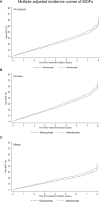The Efficacy of Alendronate Versus Denosumab on Major Osteoporotic Fracture Risk in Elderly Patients With Diabetes Mellitus: A Danish Retrospective Cohort Study
- PMID: 35154013
- PMCID: PMC8825412
- DOI: 10.3389/fendo.2021.826997
The Efficacy of Alendronate Versus Denosumab on Major Osteoporotic Fracture Risk in Elderly Patients With Diabetes Mellitus: A Danish Retrospective Cohort Study
Abstract
Objective: Patients with diabetes mellitus have an increased risk of fractures; however, the underlying mechanism is largely unknown. We aimed to investigate whether the risk of major osteoporotic fractures in diabetes patients differs between subjects initiated with alendronate and denosumab, respectively.
Methods and research design: We conducted a retrospective nationwide cohort study through access to all discharge diagnoses (ICD-10 system) from the National Danish Patient Registry along with all redeemed drug prescriptions (ATC classification system) from the Health Service Prescription Registry. We identified all subjects with a diabetes diagnosis between 2000 and 2018 and collected data on the first new prescription of anti-osteoporotic treatment between 2011 and 2018. Exposure was defined as either alendronate or denosumab treatment initiated after diabetes diagnosis. Outcome information was collected by identification of all major osteoporotic fracture (MOF) diagnoses, i.e., hip, spine, forearm, and humerus, from exposure until 2018 or censoring by emigration or death. The risk of fracture was calculated as hazard ratios (HR) using multiply adjusted Cox proportional models with death as a competing risk.
Results: We included 8,745 subjects initiated with either alendronate (n = 8,255) or denosumab (n = 490). The cohort consisted of subjects with a mean age of 73.62 (SD ± 9.27) years, primarily females (69%) and suffering mainly from type 2 diabetes (98.22%) with a median diabetes duration at baseline of 5.45 years (IQR 2.41-9.19). Those in the denosumab group were older (mean 75.60 [SD ± 9.72] versus 73.51 [SD ± 9.23] years), had a higher proportion of women (81% versus 68%, RR 1.18 [95% CI 1.13-1.24], and were more comorbid (mean CCI 2.68 [95% CI 2.47-2.88] versus 1.98 [95% CI 1.93-2.02]) compared to alendronate initiators. In addition, denosumab users had a higher prevalence of previous fractures (64% versus 46%, RR 1.38 [95% CI 1.28-1.48]). The adjusted HR for any MOF after treatment initiation with denosumab was 0.89 (95% CI 0.78-1.02) compared to initiation with alendronate.
Conclusion: The risk of incident MOF among subjects with diabetes was similar between those initially treated with alendronate and denosumab. These findings indicate that the two treatment strategies are equally effective in preventing osteoporotic fractures in subjects with diabetes.
Keywords: alendronate; bone; denosumab; diabetes; fracture; osteoporosis.
Copyright © 2022 Viggers, Al-Mashhadi, Starup-Linde and Vestergaard.
Conflict of interest statement
The authors declare that the research was conducted in the absence of any commercial or financial relationships that could be construed as a potential conflict of interest.
Figures
Similar articles
-
Comparison of Risk of Osteoporotic Fracture in Denosumab vs Alendronate Treatment Within 3 Years of Initiation.JAMA Netw Open. 2019 Apr 5;2(4):e192416. doi: 10.1001/jamanetworkopen.2019.2416. JAMA Netw Open. 2019. PMID: 31002319 Free PMC article.
-
Discrepancies in type of first major osteoporotic fracture and anti-osteoporotic therapy in elderly people with type 2 diabetes mellitus: A retrospective Danish cohort study.Bone. 2023 Jun;171:116745. doi: 10.1016/j.bone.2023.116745. Epub 2023 Mar 24. Bone. 2023. PMID: 36965654
-
The risk of major osteoporotic fractures with GLP-1 receptor agonists when compared to DPP-4 inhibitors: A Danish nationwide cohort study.Front Endocrinol (Lausanne). 2022 Oct 10;13:882998. doi: 10.3389/fendo.2022.882998. eCollection 2022. Front Endocrinol (Lausanne). 2022. PMID: 36299454 Free PMC article.
-
CLINICAL EVALUATION OF COST EFFICACY OF DRUGS FOR TREATMENT OF OSTEOPOROSIS: A META-ANALYSIS.Endocr Pract. 2017 Jul;23(7):841-856. doi: 10.4158/EP161678.RA. Epub 2017 Apr 27. Endocr Pract. 2017. PMID: 28448754 Review.
-
Denosumab, raloxifene, romosozumab and teriparatide to prevent osteoporotic fragility fractures: a systematic review and economic evaluation.Health Technol Assess. 2020 Jun;24(29):1-314. doi: 10.3310/hta24290. Health Technol Assess. 2020. PMID: 32588816 Free PMC article.
Cited by
-
Comparative effectiveness of denosumab vs alendronate among postmenopausal women with osteoporosis.J Bone Miner Res. 2024 Aug 5;39(7):826-834. doi: 10.1093/jbmr/zjae079. J Bone Miner Res. 2024. PMID: 38753892 Free PMC article.
-
Denosumab and incidence of type 2 diabetes among adults with osteoporosis: population based cohort study.BMJ. 2023 Apr 18;381:e073435. doi: 10.1136/bmj-2022-073435. BMJ. 2023. PMID: 37072150 Free PMC article.
-
Potential Targeting Mechanisms for Bone-Directed Therapies.Int J Mol Sci. 2024 Jul 30;25(15):8339. doi: 10.3390/ijms25158339. Int J Mol Sci. 2024. PMID: 39125906 Free PMC article. Review.
-
Challenges to Improve Bone Healing Under Diabetic Conditions.Front Endocrinol (Lausanne). 2022 Mar 28;13:861878. doi: 10.3389/fendo.2022.861878. eCollection 2022. Front Endocrinol (Lausanne). 2022. PMID: 35418946 Free PMC article. Review.
-
Impact of Alendronate Sodium plus Elcatonin on Postoperative Bone Pain in Patients with Osteoporotic Fractures.Biomed Res Int. 2022 Sep 7;2022:1213278. doi: 10.1155/2022/1213278. eCollection 2022. Biomed Res Int. 2022. Retraction in: Biomed Res Int. 2023 Dec 29;2023:9817304. doi: 10.1155/2023/9817304. PMID: 36119926 Free PMC article. Retracted.
References
Publication types
MeSH terms
Substances
LinkOut - more resources
Full Text Sources
Medical
Research Materials


